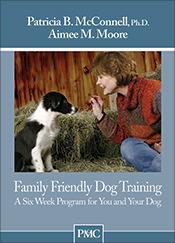The only thing better than sharing life with a dog is enjoying a dog who is responsive and well-behaved.

Even the Simpsons took Santa's Little Helper to Obedience Class
We wouldn’t expect children to learn how to behave without any guidance, and neither will dogs learn on autopilot. Last year when we got C-Biscuit, we enrolled in an 8-week basic obedience class from Follow My Lead. We thought it was the responsible thing to do and a good bonding experience. (Plus it’s required to take agility, which is what we really want to try.)
The class cost $375, though. Training is an excellent investment, but we didn’t learn anything magical in class. The techniques are freely available in books, videos, and on TV.
Here’s what we’re finding most helpful for do-it-yourself dog training with C-Biscuit and Machu Picchu:
 Family Friendly Dog Training: A Six-Week Program for You and Your Dog by Patricia McConnell, a dog behaviorist and trainer. This 100-page, $15 booklet follows the same progression as the $375 class we took, walking you through the basics of teaching a dog’s name, Sit, Come, Stay, Leave It, etc. She’s very clear, and includes a lot of tips about how dogs learn and communicate that help you become a better trainer – and pet parent.
Family Friendly Dog Training: A Six-Week Program for You and Your Dog by Patricia McConnell, a dog behaviorist and trainer. This 100-page, $15 booklet follows the same progression as the $375 class we took, walking you through the basics of teaching a dog’s name, Sit, Come, Stay, Leave It, etc. She’s very clear, and includes a lot of tips about how dogs learn and communicate that help you become a better trainer – and pet parent.

Victoria Stilwell of "It's Me or the Dog"
“It’s Me or the Dog” show on the Animal Planet channel: Trainer Victoria Stilwell is creative and uses positive techniques. Unlike the “Dog Whisperer” Cesar Milan, who is all about showing dogs who’s in charge, Stilwell liberally uses treats and games to give dogs guidance. Watching the show should give you lots of ideas about ways to train your own dog. We find the “body block” especially helpful, and her sharp “Ot!” (rather than yelling “Noooo!”). As with Cesar, she emphasizes daily EXERCISE as a basis for good behavior and the dog’s happiness.
 We also really like her book, “It’s Me or the Dog: How to Have the Perfect Pet,” which is my new favorite primer on dog care for new dog owners. It’s written in short, easily-digestible nuggets, with lots of bullet points and photos. Training doesn’t go beyond the very basics, but is a place to start.
We also really like her book, “It’s Me or the Dog: How to Have the Perfect Pet,” which is my new favorite primer on dog care for new dog owners. It’s written in short, easily-digestible nuggets, with lots of bullet points and photos. Training doesn’t go beyond the very basics, but is a place to start.
 “Feeling Outnumbered? How to manage and enjoy your multi-dog household,” also from Patricia McConnell. This is both a booklet ($10) and DVD ($30) that explains training techniques for more than one dog. I invested in the video, which features McConnell demonstrating the exercises with various dogs in her own home. Once I saw her stand in front of an open door and release her 3 dogs calmly one by one by saying their names, I was determined to get this kind of order with Biski and Picchu!
“Feeling Outnumbered? How to manage and enjoy your multi-dog household,” also from Patricia McConnell. This is both a booklet ($10) and DVD ($30) that explains training techniques for more than one dog. I invested in the video, which features McConnell demonstrating the exercises with various dogs in her own home. Once I saw her stand in front of an open door and release her 3 dogs calmly one by one by saying their names, I was determined to get this kind of order with Biski and Picchu!
If you’re not going to take a class, I think it’s helpful to watch trainers in action either on TV or video, especially since body language and tone are important. Netflix and public libraries both stock training videos, although I can’t vouch for which ones. I think this is a very appropriate area in which to splurge.









